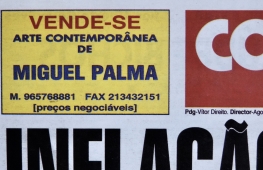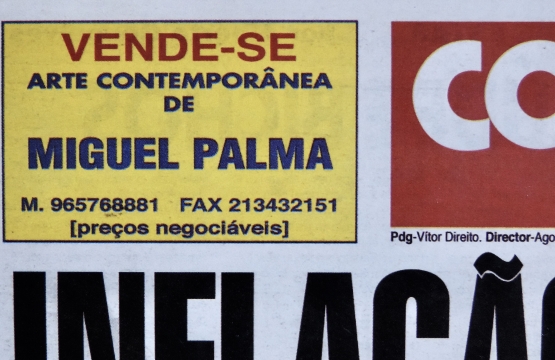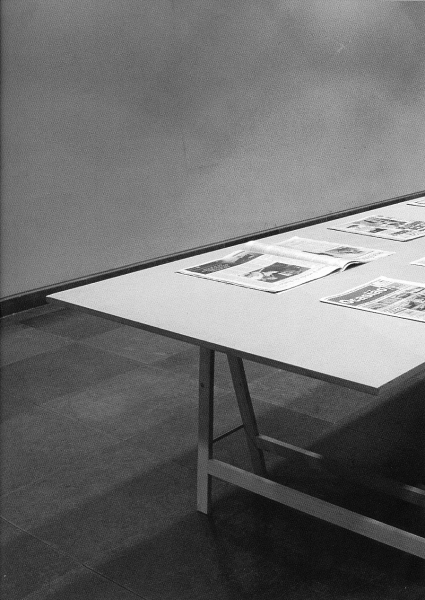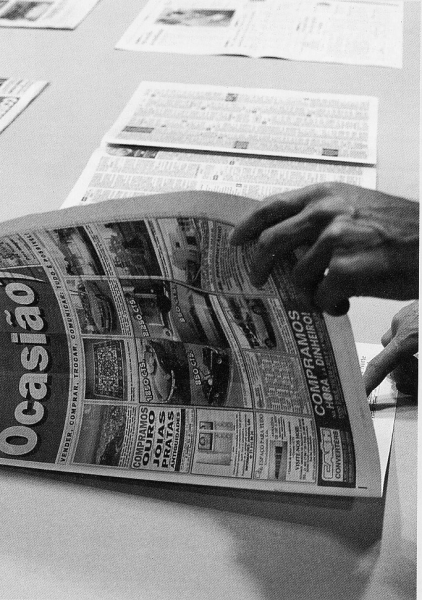The Occasion of a Decline & Other Signs
Pedro Lapa
Moi aussi, je me suis demandé si je ne pouvais pas vendre quelque chose et réussir dans la vie. Cela fait un moment déjà que je ne suis bon à rien. Je suis âgé de quarante ans...
L'idée enfin d'inventer quelque chose d’insincère me traversa l'esprit et je me mis aussitôt au travail. Au bout de trois mois, je montrai ma production à Ph. Edouard Toussaint le propriétaire de la galerie Saint Laurent. Mais, c'est de l'Art, dit-il et j'exposerais volontiers tout ça. D'accord lui répondis je. Si je vends quelque chose il prendra 30%, ce sont, paraît-il des conditions normales certaines galeries prenant 75%. Ce que c'est? En fait, des objets.Marcel Broodthaers
For the visitor to this exhibition who comes into the room and is confronted with the vast number of adverts published in many newspapers, announcing the sale or exchange of works by Miguel Palma, here presented on a counter to the sound of many telephone calls, this is the end of a process which is now concluded. Indeed, over about a month, the artist published adverts in the most varied sections of Portuguese and foreign newspapers, in which he proposed the sale or exchange of his works carried out until then, in a more or less desperate, charlatan and opportunistic manner. He was apparently going round the established circuits of a specific market - that of art - in order to cut out any mediation, to go beyond the codes and the respective conventions, and to some extent to be confronted with the resulting lack of communicability clearly shown in the sound recordings of the dialogues with those potentially interested in the objects
themselves, and certainly not in works of art.
This process thus allowed Miguel Palma to try out the codes and values associated to the work of art through out its circuits of reception, as well as natural implications as to the definition of the artistic object. It is important to recall or even draw up a genealogy within the whole of the work by this artist, and which form a defining line of his work, among others. In 1994, the work One million escudos inside a safe was literally made up of an average sized safe about which this information created an expectation frustrated by the fact that it was locked. The strategy of the readymade that the artist apparently uses is slightly moved in order to reinterpret the Dadaist procedure in the light of a different economic and cultural context.
If the Dadaist dislocation of an object from its daily use into the space of an exhibition - a space of art - carried out an indifferentiation relative to the intrinsic properties of the artistic object in relation to the non-artistic objects in order to valorize the operative logic inherent to
the Nominalist act, it is also true, and today we are able to verify this, that the place of the artistic object, a rare object / a value for exchange and sumptuary par excellence / would be subverted by the value of use carried by daily objects. It ls developing this point of view, within a remarkably synthetic manner, that One million escudos inside a safe makes the issue more complex. The question here is no longer that of the art/non-art dichotomy, nor that of an attack against the artistic institution, but a criticism of the notion of value within a historico-economic context in which the object becomes a sign. Thus the safe with money implies a commercial value as a purely functional object, but, as a work of art, does Miguel Palma imply the same value?
themselves, and certainly not in works of art.
This process thus allowed Miguel Palma to try out the codes and values associated to the work of art through out its circuits of reception, as well as natural implications as to the definition of the artistic object. It is important to recall or even draw up a genealogy within the whole of the work by this artist, and which form a defining line of his work, among others. In 1994, the work One million escudos inside a safe was literally made up of an average sized safe about which this information created an expectation frustrated by the fact that it was locked. The strategy of the readymade that the artist apparently uses is slightly moved in order to reinterpret the Dadaist procedure in the light of a different economic and cultural context.
If the Dadaist dislocation of an object from its daily use into the space of an exhibition - a space of art - carried out an indifferentiation relative to the intrinsic properties of the artistic object in relation to the non-artistic objects in order to valorize the operative logic inherent to
the Nominalist act, it is also true, and today we are able to verify this, that the place of the artistic object, a rare object / a value for exchange and sumptuary par excellence / would be subverted by the value of use carried by daily objects. It ls developing this point of view, within a remarkably synthetic manner, that One million escudos inside a safe makes the issue more complex. The question here is no longer that of the art/non-art dichotomy, nor that of an attack against the artistic institution, but a criticism of the notion of value within a historico-economic context in which the object becomes a sign. Thus the safe with money implies a commercial value as a purely functional object, but, as a work of art, does Miguel Palma imply the same value?













